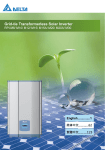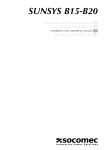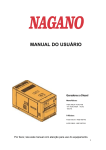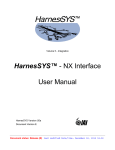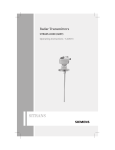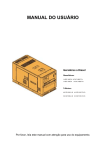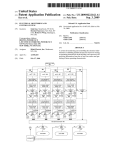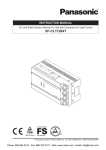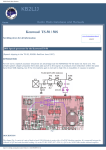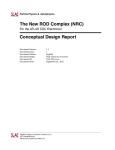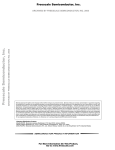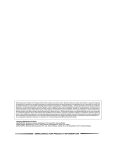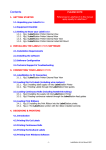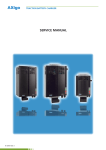Download User Manual - Delta Electronics
Transcript
i Contents Section 1. Description Page General Information ............................................................................... 6 1.1 About this Manual .......................................................................... 6 1.2 General Warnings / Notes on Safety............................................. 6 1.3 Validity ............................................................................................ 7 1.4 Product Description ....................................................................... 7 1.5 How it Works .................................................................................. 8 1.6 Additional Information ................................................................... 8 2. Installation and Wiring .......................................................................... 9 2.1 Instruction before Installation ....................................................... 9 2.2 Unpacking ....................................................................................... 9 2.3 Package Inspection...................................................................... 10 2.4 Identify of Inverter ........................................................................ 10 3. Product Overview ................................................................................ 11 3.1 Dimension ..................................................................................... 11 3.2 Function Introduction .................................................................. 12 3.2.1 LCD Display and Buttons .................................................... 12 3.2.2 Inverter Input / Output Interface ......................................... 13 4. Installation ............................................................................................ 14 4.1 Installing Location ....................................................................... 14 4.2 Mounting ....................................................................................... 14 5. Wiring.................................................................................................... 18 5.1 Preparation before Wiring ........................................................... 18 5.2 AC Grid Connection: 3-Phase+PE or 3-Phase+N+PE ............... 20 5.2.1 Required Protective Devices and Cable Cross-sections . 20 5.3 DC Connection (from PV Array) .................................................. 24 5.4 Communication Module Connections ........................................ 26 5.4.1 RS-485 Connection .............................................................. 26 5.4.2 EPO Functions ..................................................................... 28 6. 5.4.3 Dry Contact Connection ...................................................... 28 Active / Reactive Power Control and Fault Ride Through ................ 29 6.1 Active Power Control ................................................................... 29 6.1.1 Power Limit .......................................................................... 29 6.1.2 Power vs. Frequency ........................................................... 30 6.2 Reactive Power Control ............................................................... 31 6.2.1 Fixed Active Factor cosφ .................................................... 31 1 6.2.2 Active Factor cosφ(P) ......................................................... 31 7. 6.2.3 Fixed Reactive Power .......................................................... 32 6.2.4 Reactive Power / Voltage Characteristic Q(U) ................... 32 6.3 Fault Ride Through (FRT) ............................................................ 33 Turn on/off PV inverter ........................................................................ 35 7.1 Home Page ................................................................................... 37 7.2 LCD Flow Chart ............................................................................ 37 7.2.1 Power Meter ......................................................................... 37 7.2.2 Energy Log ........................................................................... 38 7.2.3 Event Log ............................................................................. 38 7.2.4 Operation Data ..................................................................... 39 7.2.5 Inverter Information ............................................................. 39 7.2.6 Settings ................................................................................ 40 7.2.6.1 Personal Setting ...................................................... 40 7.2.6.2 Coefficient Setting .................................................. 41 7.2.6.3 Installation Settings ................................................ 41 7.2.6.4 Active/Reactive Power Control .............................. 44 7.2.6.4.1 Power Limit ............................................... 45 7.2.6.4.2 7.2.6.4.3 Power vs. Frequency ................................ 45 Constant cosφ........................................... 46 7.2.6.4.4 7.2.6.4.5 7.2.6.4.6 cosφ(P) ...................................................... 46 Constant Reactive Power ......................... 47 Q(U) ............................................................ 47 8. 7.2.6.5 FRT (Fault ride through) ......................................... 48 Maintenance ......................................................................................... 49 9. 8.1 Clean Fan ...................................................................................... 49 8.2 Replace Fan .................................................................................. 50 8.3 Clean Air Outlets .......................................................................... 50 Measurement, Error message and Trouble Shooting ....................... 51 9.1 Measurement ................................................................................ 51 9.2 Error Message & Trouble Shooting ............................................ 54 10. De-Commissioning .............................................................................. 60 10.1 De-Commissioning Procedure .................................................... 60 11. Technical Data ...................................................................................... 61 11.1 Specification ................................................................................. 61 2 Figure Section Description Page Figure 1-1 Solar system operation illustration ................................................. 8 Figure 2-1 Unpacking process ........................................................................ 9 Figure 2-2 Wooden case unpacking process .................................................. 9 Figure 2-3 The identification label ................................................................. 10 Figure 3-1 Dimension of RPI-M8/ M10/ M12/ M15A/ M20A .......................... 11 Figure 3-2 Dimension of RPI-M15/ M20/ M30 ............................................... 11 Figure 3-3 Inverter exterior objects ............................................................... 12 Figure 3-4 LCD display and control panel ..................................................... 12 Figure 3-5 Input/Output interfaces of M8/ M10/ M12/ M15A/ M20A .............. 13 Figure 3-6 Input/Output interfaces of M15/ M20/ M30................................... 13 Figure 3-7 Air outlet illustration ..................................................................... 13 Figure 4-1 Screw the mounting bracket ........................................................ 15 Figure 4-2 Correct and incorrect installation illustration ................................ 16 Figure 4-3 Proper installation gap ................................................................. 17 Figure 5-1 Connection of a system for floating DC inputs ............................. 18 Figure 5-2 Connection of system with positive/negative ground ................... 19 Figure 5-3 Stripping the wire ......................................................................... 21 Figure 5-4 AC plug illustrationfor M8/ M10/ M12/ M15/ M15A/ M20/ M20A. . 22 Figure 5-5 AC plug illustration for M30 .......................................................... 23 Figure 5-6 DC Wiring illustration ................................................................... 25 Figure 5-7 Communication module ............................................................... 26 Figure 5-8 Multi-inverter connection illustration ............................................ 27 Figure 5-9 Dry contact port & Assignments ................................................... 28 Figure 6-1 Power vs. frequency characteristic .............................................. 30 Figure 6-2 cosφ(P) characteristic .................................................................. 31 Figure 6-3 Q(U) characteristic. ...................................................................... 32 Figure 6-4 Borderlines of the voltage profile of a type-2 generating plant at the network connection point .............................................................................. 34 Figure 6-5 FRT characteristic ........................................................................ 34 Figure 7-1 LCD display &control panel ......................................................... 35 Figure 7-2 Select county page ...................................................................... 36 Figure 7-3 Select language page .................................................................. 36 Figure 7-4 Home page .................................................................................. 37 Figure 7-5 Menu page................................................................................... 37 3 Figure 7-6 Power meter page ....................................................................... 37 Figure 7-7 Energy log flow chart ................................................................... 38 Figure 7-8 Event log flow chart ..................................................................... 38 Figure 7-9 Operation data flow chart............................................................. 39 Figure 7-10 Inverter information page ........................................................... 39 Figure 7-11 Setting page ............................................................................... 40 Figure 7-12 Personal setting page ................................................................ 40 Figure 7-13 Coefficient setting page ............................................................. 41 Figure 7-14 Install setting page –User mode ................................................ 42 Figure 7-15 Insulation setting ........................................................................ 42 Figure 7-16 Install setting page – Installer mode .......................................... 42 Figure 7-17 Grid setting page ....................................................................... 43 Figure 7-18 Active/Reactive powersetting page ............................................ 44 Figure 7-19 Power limit setting page............................................................. 45 Figure 7-20 Power vs. frequency setting page. ............................................. 45 Figure 7-21 Constant cosφ setting page ....................................................... 46 Figure 7-22 cosφ(P) setting page ................................................................. 46 Figure 7-23 Constant Reactive Power setting page ...................................... 47 Figure 7-24 Q(U) setting page ...................................................................... 47 Figure 7-25 FRT setting page ....................................................................... 48 Figure 8-1 dissembling fan connections........................................................ 49 Figure 8-2 disassembling fan overview ......................................................... 50 Figure 8-3 Disassembling fan ....................................................................... 50 Figure 8-4 Disassembling air outlets ............................................................. 50 4 Table Section Description Page Table 2-1 Packing list .................................................................................... 10 Table 5-1 Recommended upstream protection ............................................. 20 Table 5-2 Wire size of AC input ..................................................................... 20 Table 5-3 The wiring system of the inverter. .................................................. 23 Table 5-4 Maximum rating of input power ..................................................... 24 Table 5-5 Cable size ..................................................................................... 24 Table 5-6 Definition of RS 485 pin................................................................. 26 Table 5-7 RS-485 data format ....................................................................... 27 Tabel 5-8 Terminal resister setting ................................................................ 27 Tabel 5-9 EPO functions ............................................................................... 28 Table 7-1 LED indicator ................................................................................. 36 Table 7-2 Grid setting parameters ................................................................. 43 Table 9-1 Measurement and message .......................................................... 51 Table 9-2 Error Message ............................................................................... 54 Table 9-3 Warning Message ......................................................................... 55 Table 9-4 Fault Message ............................................................................... 56 Table 11-1 Specification for RPI-M8/ M10/ M12 ............................................ 61 Table 11-2 Specification for RPI-M15/ M20/ M30 .......................................... 64 Table 11-3 Specification for RPI-M15A/ M20A .............................................. 67 5 1. General Information 1.1 About this Manual Congratulations on the purchase of your Delta RPI-M8/ M10/ M12/ M15/ M15A/ M20/ M20A/ M30 grid-tied solar inverter. This manual will assist you in becoming familiar with this product. Please observe all safety regulations and take into account technical connection conditions required at your local grid utility. 1.2 General Warnings / Notes on Safety Careful handling of the product will contribute to service life durability and reliability. Both are essential to ensure maximum yield from your product. As some of the solar inverter models are heavy, two people may be required for lifting purposes. CAUTION! During operation of electrical devices, certain parts are under dangerous voltage. Inappropriate handling can lead to physical injury and material damage. Always adhere to the installation regulations. Installation may only be conducted by certified electricians. WARNING! Repair work on the device should ONLY be carried out by the manufacturer. No user serviceable parts inside. Please observe all points in the operation and installation manual. Isolate the device from the grid and the PV modules before undertaking work on the device. DANGER! To avoid risk of electrical shock, do not open the solar inverter. The inverter contains no internal user-serviceable parts. Opening the inverter will void the warranty. Dangerous voltage is present for 5 minutes after disconnecting all sources of power. Remember that the unit has a high leakage current. The PE conductor MUST be connected prior to commencing operation. 6 WARNING:BURN HAZARD The unit may reach very high temperatures and the device surface can become quite hot. Sufficient cooling time is necessary for optimal yield. 1.3 Validity This user manual describes the installation process, maintenance, technical data and safety instructions of the following solar inverter models under the DELTA brand. ◆RPI-M8 ◆ RPI-M10 ◆ RPI-M12 ◆RPI-M15 ◆ RPI-M15A ◆ RPI-M20 ◆RPI-M20A ◆ RPI-M30 1.4 Product Description This device is a 3-phase grid-tied solar inverter. It converts direct current (DC) electricity from the PV array into 3-phase alternating current (AC) which feeds the excess generated power back to the local grid. This inverter allows for a wide voltage range (200~1000V) and has a high performance efficiency and user friendly design and operation. Please note these devices do not support off-grid functionality. The features for RPI-M8/ M10/ M12/ M15/ M15A/ M20/ M20A/ M30 are shown below. Features Power Rating:8/ 10/ 12/ 15/ 20/ 30 kVA 3Phase, Grid-tie, Transformerless solar inverter Maximum efficiency:> 98 % Europe efficiency: >97.5% Reactive power capability (Cap 0.8 – Ind 0.8) Low output current harmonic distortion (THD < 3%) @ full load 2 MPP Trackers Record up to 30 event logs. 5” LCD display 7 1.5 How it Works The operation of solar inverter is shown as the figure 1-1. In order to save energy and electricity, solar inverter convert the DC input power supplied from the PV Array into 3-phase AC output power to Grid. Solar Inverter Electrical Grid PV Array 3PH DC Distribution box AC Distribution box 3 phase, N, PE Surge arrestor Fuse E-Today: 47kWh Runtime: 8.2Hrs 21. Jun 2010 13:50 Power: 12103W On Grid, Derating, cosφ – Ind 0.9 20 15 10 5 0 4 8 12 16 20 24 Surge arrestor AC breaker DC switch Figure 1-1 Solar system operation illustration 1.6 Additional Information For more detailed information for RPI-M8/ M10/ M12/ M15/ M15A/ M20/ M20A/ M30 or other related product information, please visit http://www.deltaww.com. 8 2. Installation and Wiring 2.1 Instruction before Installation Due to the variety of users and installation environments, it is recommended to read this manual thoroughly before installation. Installation of the unit and start-up procedures must be carried out by accredited technicians. 2.2 Unpacking Unpacking process for RPI-M8/ M10/ M12/ M15A/ M20A is shown as Figure 2-1. a. b. c. Figure 2-1 Unpacking process Unpacking process for RPI-M15/ M20/ M30 is shown as Figure 2-2. 4 5 6 1 2 3 a. b. c. Figure 2-2 Wooden case unpacking process 9 2.3 Package Inspection Unforeseeable events causing damage or movement may occur during shipment. Please check for damage on the wooden carton upon receiving your inverter. Please check the model number and the serial number on the packaging is identical with the model number and serial number on the unit itself. Check if all the accessories are in the package, the standard accessories are list as Table 2-1: Table 2-1 Packing list RPI-M8/ M10/ M12/ M15/ M15A/ M20/ M20A/ M30 Object Qty Description PV Inverter 1 RPI-M8/ M10/ M12/ M15/ M15A/ M20/ M20A/ M30 solar inverter User Manual 1 The Instruction to provide the information of safety, Installation, specification, etc. AC Plug 1 Connector for AC connection Mounting Bracket 1 Wall mounting bracket to mount the solar inverter on the wall Caution: If there is any visible damage to the inverter/accesories or any damage to the packaging, please contact your inverter supplier. 2.4 Identify of Inverter Users can identify the model number by the information on the product label. The model number, specification and the series No. is specified on the product label. Regard to the label location, please refer to the figure 2-3. RPI-M8/ M10/ M12 RPI-M15A/ M20A RPI-M15/ M20/ M30 Figure 2-3 The identification label 10 3. Product Overview 3.1 Dimension Top view 198 [7.8] 625 [24.6] 326 [12.8] 612 [24.1] 278 [10.9] Front view Side view RPI-M8/ M10/ M12 Back view RPI-M15A/ M20A Bottom view Figure 3-1 Dimension of RPI-M8/ M10/ M12/ M15A/ M20A Top view 278 [10.9] 960 [37.8] 931 [36.6] 331 [13.0] 203 [8.0] 612 [24.1] Front view Side view Back view 260 [10.2] RPI-M20 / RPI-M15 Bottom view RPI-M30 Figure 3-2 Dimension of RPI-M15/ M20/ M30 11 3.2 Function Introduction The Inverter’s exterior objects are shown in Figure 3-3. The detailed description can be found in sections 3.2.1 and 3.2.2. LCD/LED Display and Buttons Air outlets Communication Connetions LCD/LED Display and Buttons Communication Connetions Air outlets Fan*1 or 2 Label AC Connectors RPI-M15/ M20/ M30 DC Switch Fan*4 AC Connectors DC Switch Label RPI-M8/ M10/ M12/ M15A/ M20A DC Connectors DC Connectors Figure 3-3 Inverter exterior objects 3.2.1 LCD Display and Buttons LCD Display EXIT: Exit Menu Down: Move Down ENT: Enter Menu or Confirm LED Indicator (GRN/RED) UP: Move Up Figure 3-4 LCD display and control panel 12 3.2.2 Inverter Input / Output Interface DC1 DC2 String1 String3 String2 String4 RPI-M8/ M10/ M12/ M15A/ M20A AC Connector DC Switch 230/400Vac, 3Ph Communication Fan*1 or 2 -RS-485 *2 -EPO *2 -Dry Contact *2 Figure 3-5 Input/Output interfaces of M8/ M10/ M12/ M15A/ M20A DC1 DC2 String1 String3 String2 String4 RPI-M15/ M20 DC1 DC2 AC Connector DC Switch 230/400Vac, 3Ph Communication -RS-485 *2 -EPO *2 -Dry Contact *2 Fan *4 String1 String4 String2 String5 String3 String6 RPI-M30 Figure 3-6 Input/Output interfaces of M15/ M20/ M30 Figure 3-7 Air outlet illustration 13 4. Installation 4.1 Installing Location WARNING! Do not install the unit near or on flammable surfaces. Please mount the unit tightly on a solid/smooth surface. CAUTION! The unit should not be installed in a direct sunlight. 4.2 Mounting This unit is designed to be wall-mounted. Please ensure the installation is perpendicular to the wall and the AC plug at the base of the unit. Do not install the device on a slanting wall. The dimensions of the mounting bracket are shown in the figure below. There are 12pcs of M6 screws required for mounting plate. Fix the supplied wall-mount plate securely on the wall before attaching the 931 [36.6] 331 [13.0] 203 [8.0] 198 [7.8] 326 [12.8] inverter onto the mounting plate. Back view Back view 260 [10.2] 14 M6 Screw M6 Screw Wall M6 Screw *6 M6 Screw *6 > 70cm > 80cm Inverter #1 Inverter #2 > 80cm > 125cm Figure 4-1 Screw the mounting bracket 15 90 Figure 4-2 Correct and incorrect installation illustration CAUTION! ◆ The bracket supplied with the unit is specially designed and should be the only mounting device used for the unit. ◆ It is recommended to install the inverter in a suitable location which offers non-obscured and safe access, in turn ensuring easy access for service and maintenance. ◆ Please leave an appropriate gap in between units when installing several solar inverter systems. ◆ Please install solar inverter at an eye level to allow easy observation for operation and parameter setting. ◆ Ambient temperature -20°C~60°C.(power derating above 40°C) ◆ It is essential to ensure sufficient space for product operation as shown in Figure 4-3. 16 > 60 CM > 60 CM > 60 CM > 60 CM > 60 CM Figure 4-3 Proper installation gap 17 5. Wiring 5.1 Preparation before Wiring 1. Ensure voltage values and polarities are correct. 2. When grounding the solar array, an isolation transformer is required due to the RPI-series not having galvanic isolation between the DC-input and AC-output. 3. 4. 5. The ground fault detection is a fixed internal setting. It cannot be modified. Whole system wiring and connections can be seen in Figure 5-1 and 5-2. Inverter can accept DC inputs in parallel (1 MPP tracker/2 parallel inputs). 6. Different DC connection type needs different settings of insulation detection. About setting, please refer to 7.2.6.3 Install Setting. PV Array DC Distribution box DC1 DC2 2 DC Wiring Parallel or Separate 1 AC Wiring 1 2 3 4 L1 L2 L3 N * PE * Some models can support 3P3W system, please refer to table 5-3. 3 Communication Wiring Figure 5-1 Connection of a system for floating DC inputs 18 PV Array DC Distribution box (Plus-GND or Minus-GND) or Z Z Must be Parallel Connection Must install a transformer Isolated transformer Utility 3Ph, 400Vac To Inverter 3Ph, 400Vac Some models can support 3P3W system, please refer to table 5-3. Figure 5-2 Connection of system with positive/negative ground WARNING! SHOCK HAZARD Note: Whenever a PV array is exposed to sunlight, a shock hazard may exist due to output wires or exposed terminals. To reduce the risk of shock during installation, cover the array with an opaque (dark) material and ensure that the Disconnect Device in the inverter is set to OFF before commencing any wiring. 19 5.2 AC Grid Connection: 3-Phase+PE or 3-Phase+N+PE WARNING! Death and serious injuries may occur. Before AC wiring, please ensure AC breaker is switched off. 5.2.1 Required Protective Devices and Cable Cross-sections It is recommended to install upstream circuit breakers between AC side and inverter side for over current protection. Table 5-1 Recommended upstream protection Model Upstream circuit breaker RPI-M8 20A RPI-M10 20A RPI-M12 30A RPI-M15 30A RPI-M15A 30A RPI-M20 40A RPI-M20A 40A RPI-M30 60A L3 L2 L1 N To solar inverter AC plug PE G N L1 L2 L3 The AC cable must be jacked and meet the specification in table 5-2. Table 5-2 Wire size of AC input Model Current Rating Wire size Torque Temperature 40 A 5 - 8 mm2 0.7 N m Meet UL 10070 60 A 10 mm2 or 6 AWG 3Nm Meet UL 10070 RPI-M8 RPI-M10 RPI-M12 RPI-M15 RPI-M15A RPI-M20 RPI-M20A RPI-M30 20 AC’s wiring can be separated into 3-phase and PE (3P3W) or 3-phase, N, and PE (3P4W). Only some models can support 3P3W system. Please refer to table 5-3. The following instruction is based on 3P4W. If the grid system is 3P3W, please ignore the description of N. CAUTION! Machine and equipment damage may occur. ◆ ◆ Make sure to choose the correct wire size AC cable. Failure to follow these instructions may cause AC plug damage. Follow the steps below to strip the wires before assembling the AC plug: a) Trim the L1, L2, L3, and N wire to 52.5 mm (2.0 inch). b) Strip 12 mm (0.5 inch) of insulation from all wire ends. c) Remove 55 mm (2.2 inch) of AC cable outer jacket. Figure 5-3 Stripping the wire 21 Assemble the AC plug and wires as the procedures shown in figure 5-4(for all models except RPI-M30) and figure 5-5(for RPI-M30 model only). Inverter allows either positive or negative phase sequence. That means the sequence of L1~ L3 can be reversed. However, N and PE must be connected correctly. 1 : L1 2 : L2 3 : L3 4:N : PE PE L1 Fix it Rotate to loose the AC plug L2 L1 L2 L3 Cable N PE N L3 Align the biggest latch of the AC plug and the socket AC Plug Cable Socket Inverter AC plug Inverter Rotate to tighten the inserter Cable Rotate to tighten the plug Rotate gland to fix cable Cable Figure 5-4 AC plug illustrationfor M8/ M10/ M12/ M15/ M15A/ M20/ M20A. 22 Fix it Rotate to loose the AC plug L1 N L1 L2 L3 N L3 L2 PE PE Inverter Rotate to tighten the AC plug Rotate to tighten the plug Rotate gland to fix cable AC plug Figure 5-5 AC plug illustration for M30 Table 5-3 The wiring system of the inverter. Model Wiring RPI-M8/ M10/ M12 3P3W+PE ╳ RPI-M15/ M20 P/N: RPIXX3N5430098 or 09 ╳ 3P4W+PE Model Wiring RPI-M15/ M20 P/N: RPIXX3N5431000 3P3W+PE 3P4W+PE RPI-M15A/ M20A/ M30 After wiring, installer should choose the AC connection type on the control panel. About setting, please refer to 7.2.6.3 Install Setting. The AC voltage should be as followings: 3P3W 3P4W L1-L2: 400 Vac 10% L1-L3: 400 Vac 10% L2-L3: 400 Vac 10% L1-N: 230 Vac 10% L2-N: 230 Vac 10% L3-N: 230 Vac 10% 23 5.3 DC Connection (from PV Array) WARNING! When undertaking DC wiring, please ensure the correct polarities are connected. When undertaking DC wiring, please ensure that the power switch on the PV array is OFF. CAUTION! ◆ The connection number of PV Array, open circuit voltage and power of String_1 and String _2 must be coherent. ◆ The connection number of PV Array, open circuit voltage and power of String _3 and String _4 must be coherent. ◆ The maximum open circuit voltage of PV Array cannot be higher than 1000V. ◆ The range of MPP Voltage of Input1 and Input2 shall be in 350~800 Vdc. ◆ The device installed between PV Array and inverter must meet the following specifications: a.) Rated voltage > open-circuit voltage of PV Array. b.) Rated current > short-circuit current of PV Array. ◆ The input power to the inverter should not higher than the rated power shown in table 5-4. Table 5-4 Maximum rating of input power Type of limit RPI-M8 RPI-M10 RPI-M12 RPI-M15 Total input power Input1 or Input2 8.8 kW 11 kW 13.2 kW 16.5 kW 5.9 kW 7.4 kW 8.8 kW 8.25 kW RPI-M15A RPI-M20 RPI-M20A RPI-M30 Total input power 16.5 kW 22 kW 22 kW 32 kW Input1 or Input2 8.25 kW 11 kW 11 kW 16 kW Type of limit Table 5-5 Cable size Model Current Rating Wire size Temperature M8 DC 10A 2 - 3mm2 / 14 AWG Meet UL 10070 M10/ M12 DC 20A 3 - 5mm2 / 12 AWG Meet UL 10070 M15A/ M20A DC 34A 5 - 6mm2 / 10 AWG Meet UL 10070 M15/ M20/ M30 DC 34A 2 5 - 6mm / 10 AWG Meet UL 10070 24 DC wiring polarity is divided into positive and negative, which is shown as in Figure 5-6. The connection shall be coherent with the indication marked on inverter. PV-KBT4/6 Ⅱ PV-KST4/6 Ⅱ Figure 5-6 DC Wiring illustration 25 5.4 Communication Module Connections The Communication Module supports the functions of communication with a computer. There are two types of modules. One has RJ45-type RS-485 connector, and the other has terminals-type RS-485 connector. Terminal Resistor GND RS-485 VCC RS-485 +-+ Dry contact (3A / 28V) EPO (Emergency Power off) EPO (Emergency Power off) Terminals-type RJ45-type Figure 5-7 Communication module 5.4.1 RS-485 Connection The pin definition of RS-485 is shown as in table 5-6. Installers should switch ON the terminal resistor when single inverter is installed. The wiring of multi-inverter connection is shown as figure 5-8. Installers should switch ON terminal resister at the first and last devices of the RS485 chain as shown in Figure 5-8. The other terminal resisters should be switched OFF. Please refer to table 5-8 for the terminal resister setting. Table 5-6 Definition of RS 485 pin Pin Function Pin Function 4 DATA- 1 VCC (+12V) 5 DATA+ 2 GND 7 VCC (+12V) 3 DATA+ 8 GND 4 DATA- 5 DATA+ 6 DATA- RJ45-type 123456 Terminals-type 26 Terminal Resister 120Ω(1/2W) DATA+ to DATATerminal Resister 120Ω(1/2W) DATA+ to DATA- Pin Layout: PIN FUNCTION 4 DATADATA+ 5 7 VCC(+12V) 8 GND Data Format: Baud rate: 9600 Data bits: 8 Stop bit: 1 Parity: N/A RS485/USB or RS485/RS232 Figure 5-8 Multi-inverter connection illustration Table 5-7 RS-485 data format RS-485 Data format Baud rate 9600, 19200, or 38400 Data bit 8 Stop bit 1 Parity N/A Tabel 5-8 Terminal resister setting ON SW ON SW 1 2 OFF OFF OFF ON OFF ON OFF ON ON ON Terminal Resistor SW OFF 1 2 27 5.4.2 EPO Functions RJ45-type Communication Module provides 2 sets of emergency power off function (EPO1 and EPO2). Terminals-type Communication Module only has 1 set of EPO (EPO1). When the outer external switch is shorted, the inverter will shutdown immediately. Tabel 5-9 EPO functions Enable EPOs EPO1 Short Pin1 & Pin2 EPO2 Short Pin4 & Pin5 5.4.3 Dry Contact Connection RPI-series provides 1 set of Dry Contact function. When inverter is on grid, Com & NO2 will be shorted. When the Fan Fail is detected, Com & NO1 will be shorted. Figure 5-9 Dry contact port & Assignments 28 6. Active / Reactive Power Control and Fault Ride Through Installers can adjust Active/Reactive power control only when Grid System are set to: Germany MV, Germany LV, Italy LV, or Italy MV (a password is required to change these settings). Fault ride through (FRT) can only be adjusted when Grid System is set to: Germany MV, Italy MV, or Italy LV. There are 2 settings for active power control and 4 settings for reactive power control that can be configured based on the requirement of the local network operator. It can be configured to have active power control and/or one of the reactive power control functions. 6.1 Active Power Control 6.1.1 Power Limit According to BDEW’s technical guideline in page 25 (June 2008 version): It must be possible to operate the generating facility at reduced power output. In the cases listed below, the network operator is entitled to require a temporary limitation of the power feed-in or disconnect the facility: - potential danger to secure system operation, congestion or risk of overload on the network operator’s network, risk of islanding, - risk to the steady-state or dynamic network stability, - rise in frequency endangering the system stability, - repairs or implementation of construction measures, within the scope of generation management/ feed-in management/ network security management (see „Grundzüge zum Erzeugungsmanagement“) - User can reduce inverter output power by set percentage of actual or rated power. Please refer to 7.2.6.4.1 Power Limit for the settings procedure. 29 6.1.2 Power vs. Frequency There’re 2 different operation curves that depend on Country setting. Germany LV: follow the curve in Figure 6-1-a Germany MV/ Italy BT/ Italy MT: follow the curve in Figure 6-1-b legend: Pm is the power generated at the time of exceeding fstart P f fstart is the feeding power is the mains frequency is the frequency when the power reduction starts fstop is the frequency when there is has zero power Gradient is the slope of power reduction Configuration can be made to meet the requirements from the network operator. Please refer to 7.2.6.4.2 Power vs. Frequency for the settings procedure. P P Pm Pm Gradient Gradient f (Hz) f(Hz) f start 6-1-a f stop f recovery f start f stop 6-1-b Figure 6-1 Power vs. frequency characteristic 30 6.2 Reactive Power Control According to BDEW: With active power output, it must be possible to operate the generating plant in any operating point with at least a reactive power output corresponding to a active factor at the network connection point of cos φ = 0.95 underexcited to 0.95 overexcited Values deviating from the above must be agreed upon by contract. In the consumer reference arrow system (see Annex B.4), that means operation in quadrant II (under-excited) or III (overexcited).With active power output, either a fixed target value for reactive power provision or a target value variably adjustable by remote control (or other control technologies) will be specified by the network operator in the transfer station. The setting value is either a) b) a fixed active factor cosφ or a active factor cosφ(P) or c) d) a fixed reactive power in MVar or a reactive power/voltage characteristic Q(U). 6.2.1 Fixed Active Factor cosφ Configurations can be made to set the power factor from Cap 0.8 to Ind 0.8 (inverter would stop reactive power control if output power is below 10% rated power). 6.2.2 Active Factor cosφ(P) Once user enables this method, inverter will deliver the reactive current according to output active power in that moment. The below figure is an example. Please refer to 7.2.6.4.4 cosφ(P) for the settings procedure. cosφ Cap 0.85 1 P/Pn Ind 0.85 Figure 6-2 cosφ(P) characteristic 31 6.2.3 Fixed Reactive Power When this function is enabled, the inverter will send reactive power (ie. Q) in relation to the fixed reactive power setting. The range is Cap 53% to Ind 53%. 6.2.4 Reactive Power / Voltage Characteristic Q(U) After selecting “Q(U) control”, User can adjust “Q” against the Grid voltage operation curves shown in Figure 6-3. V V V2s V1s Qs limit V1i V2i CurveA V2s Qi limit V1s Qs limit V1i Qi limit Q V2i CurveB Figure 6-3 Q(U) characteristic. 32 6.3 Fault Ride Through (FRT) According to BDEW: 2.5.1.2 Dynamic network support Dynamic network support means voltage control in the event of voltage drops within the high and extra-high voltage network with a view to avoiding unintentional disconnections of large feed-in power, and thus network collapse. In the light of the strong increase in the number of generating plants to be connected to the medium-voltage network, the integration of these plants into the dynamic network support scheme is becoming ever more important. Consequently, these generating plants must generally participate in dynamic network support even if this is not required by the network operator at the time of the plant’s connection to the network. That means that generating plants must be able in technical terms not to disconnect from the network in the event of network faults, to support the network voltage during a network fault by feeding a reactive current into the network, not to extract from the medium-voltage network after fault clearance more inductive reactive power than prior to the occurrence of the fault. These requirements apply to all types of short circuits (i.e. to single-phase, two-phase and three-phase short circuits). Just like in the Transmission Code 2007 7, a distinction is made in these guidelines between type-1 and type-2 generating plants with regard to their behaviour in the event of network disturbances. A type-1 generating unit exists if a synchronous generator is directly (only through the generator transformer) connected to the network. All other plants are type-2 generating units. The following conditions shall apply to type-2 generating plants, taking the Transmission Code 2007, Section 3.3.13.5, into account: Generating units must not disconnect from the network in the event of voltage drops to 0 % Uc of a duration of ≤ 150 ms. Below the blue line shown in Figure 2.5.1.2-2, there are no requirements saying that generating plants have to remain connected to the network. Voltage drops with values above the borderline 1 must not lead to instability or to the disconnection of the generating plant from the network (TC2007; 3.3.13.5, section 13; extended to asymmetrical voltage drops). If the voltage drops at values above the borderline 2 and below the borderline 1, generating units shall pass through the fault without disconnecting from the network. Feed-in of a short-circuit current during that time is to be agreed with the network operator. In consultation with the network operator, it is permissible 33 to shift the borderline 2 if the generating plant’s connection concept requires to do so. Also in consultation with the network operator, a short-time disconnection from the network is permissible if the generating plant can be resynchronized 2 seconds, at the latest, after the beginning of the short-time disconnection. After resynchronization, the active power must be increased with a gradient of at least 10% of the nominal capacity per second (TC2007; 3.3.13.5, section 14). Figure 6-4 Borderlines of the voltage profile of a type-2 generating plant at the network connection point RPI-M8/ M10/ M12/ M15/ M15A/ M20/ M20A/ M30 implements the FRT behavior as the figure below, in area 1. Keep normally operate 2. Feed-in reactive current according to ΔU/Un and K factor 3. Short-time disconnect 4. Long-time disconnect IB/In Ugrid/Unom 100% K factor -10 K factor +10 1 U2 U/Un 2 3 U1 4 Udrop 0 t1 t2 t3 time Fault occurence Figure 6-5 FRT characteristic 34 7. Turn on/off PV inverter WARNING:BURN HAZARD The enclosure temperature may exceed over 70°C while operating. To avoid injury, do not touch the surface of the inverter whilst the unit is in operation. After installation, please ensure the AC, the DC and communication connection are correct. Switch on the DC switch. When enough power is generated from the PV array, the device will operate automatically and will initially ‘self-test’. This self-test takes approximately 2 minutes and will occur at first start-up of the day. The display on the inverter includes a 320x240 pixel LCD display and LED indicator lights to indicate inverter status. The green and red colour LED indicator light represents different inverter statuses. LCD Display EXIT: Exit Menu Down: Move Down ENT: Enter Menu or Confirm LED Indicator (GRN/RED) UP: Move Up Figure 7-1 LCD display &control panel 35 Table 7-1 LED indicator Condition Green LED Red LED Standby or Countdown FLASH *1 OFF OFF Power ON ON Error or Fault OFF ON Night time (No DC) OFF OFF FLASH *2 Bootloader mode *1 ON 1s / OFF 1s *2 ON 1s / OFF 1s, Green and Red are interleaving On the first start up, the country and language has to be set. The system will show the main menu after these are set. Select Country – 1/3 Confirm Country 21. Jun 2010 13:50 Australia ENT Austria Belgium China Czech England France 21. Jun 2010 13:50 Are you sure to set county : xxxxxxxx EXIT No Yes Figure 7-2 Select county page Select Language 21. Jun 2010 13:50 English Deutsch Français Italiano Español Nederlands Figure 7-3 Select language page 36 7.1 Home Page When inverter is operating normally, the LCD will display the homepage as shown in Figure 7-4, user can get the information of output power, inverter status, E-today, date and time. Today Energy E-Today: 47kWh Today Runtime Runtime: 8.2Hrs Inverter Status 21. Jun 2010 13:50 Power: 12103W Day - Time Output Power On Grid 20 15 Today Power Curve 10 5 0 4 8 12 16 20 24 Figure 7-4 Home page 7.2 LCD Flow Chart Press the EXIT button to enter the menu page (Figure 7-5). The option “E-today” is the homepage. Power Meter Energy Log 7.2.1 7.2.2 Event Log Operation Data 7.2.3 7.2.4 Inverter Information Setting 7.2.5 7.2.6 Menu E-Today Power Meter Energy Log Event Log Operation Data Inverter Information Setting Figure 7-5 Menu page 7.2.1 Power Meter This page shows the information about input and output power. Power Meter P V I Input1 1420 222 6.4 21. Jun 2010 13:50 Input2 1455 225 6.5 Today Energy: Today Runtime: Today Earning: Today CO2 Saved: Output 1480 224 6.6 W V A 0 kWh 0.0 Hours 0 € 0.0 kg Figure 7-6 Power meter page 37 7.2.2 Energy Log Press ENTER on this page to view the historical data on the power generated from a yearly, monthly and daily basis. Energy Log - Total Energy Log - Year 21. Jun 2010 13:50 3651 Hours Life Runtime: Total CO2 Saved: Total Earning: ENT 54312 kg 0 € Energy Log - Month 21. Jun 2010 13:50 2010 kWh 29200 kWh Life Energy: 180 150 120 90 60 30 0 ENT 1 2 3 4 5 6 7 8 9 10 11 12 Month EXIT 2354 kWh Peak Month: May, E-Year: History Exit 2009 ENT 1 2 3 4 5 E-Year: Exit 6 7 10 9 10 11 12 Month 2010 25 30 Day 0 4 8 Exit 12 16 20 24 Hour 86 kg Year 2010.06.20 EXIT 21. Jun 2010 13:50 2010.05 Energy Log - Day kW 20 21. Jun 2010 13:50 2010.06.20 ENT 15 10 5 1 E-Month: Exit Month ENT Peak Hour: 01 pm, 14 kWh E-Day: 46 kWh Day CO2 Saved: Day ENT 5 10 Peak Day: 15, EXIT 20 Month CO2 Saved: 2690 kg 2010.05 kWh 8 15 92 kWh 1447 kWh 180 150 120 90 60 30 0 29200 kWh Year CO2 Saved: 54312 kg 2008 5 Energy Log - Month 2490 kWh Peak Month: Jul, 1 EXIT 2009 kWh 21. Jun 2010 13:50 2010.06.21 5 Exit 21. Jun 2010 13:50 kW 15 10 E-Month: Month Energy Log - Year 4500 3750 3000 2250 1500 750 0 20 ENT Peak Day: 06, 17033 kWh Year CO2 Saved: 31681 kg Energy Log - Day 21. Jun 2010 13:50 2010.06 kWh 4500 3750 3000 2250 1500 750 0 15 20 25 30 Day 95 kWh 2480 kWh 2010.04 Month CO2 Saved: 4612 kg 2010.06 Day 0 4 8 12 16 20 Peak Hour: 01 pm, 15 kWh E-Day: 80 kWh Day CO2 Saved: Exit 2010.06.19 2010.06.21 24 Hour 149 kg Year EXIT Figure 7-7 Energy log flow chart 7.2.3 Event Log This page displays all the events (errors or fault) and it can show 30 records at at a time. Press ENTER to view all the statistical data. Event Log Event Summary – 1/8 21. Jun 2010 13:50 Event 21. Jun 2010 13:50 Count 1. 15/02/2010 17:02 AC Freq High 2. 02/12/2009 09:13 No Grid HW DC Injection 1 2 3. 23/11/2009 15:28 HW Fan Temperature 1 0 4. 03/10/2009 06:02 Insulation HW NTC1 Fail 0 5. 27/05/2009 05:52 Insulation HW NTC2 Fail 0 6. 18/02/2009 16:46 HW DC Injection HW NTC3 Fail 0 HW NTC4 Fail 0 Summary ENT EXIT Figure 7-8 Event log flow chart 38 7.2.4 Operation Data The operation data is split into 4 pages. It records the maximum and/or minimum values of history; including voltage, current, power and temperature. Operation Data – 1/4 Input1 21. Jun 2010 13:50 or Maximum Voltage (Vdc) 811 Current (A) 25.2 Power (W) 11200 ENT Operation Data – 2/4 L1 L2 Input2 Voltage (Vdc) 785 Current (A) 26.3 Power (W) 10301 21. Jun 2010 13:50 Maximum L3 Voltage (Vdc) 247 Current (A) 30.5 Power (W) 6810 Voltage (Vdc) 244 Current (A) 30.3 Power (W) 6756 Voltage (Vdc) 245 Current (A) 30.1 Power (W) 6745 or or ENT ENT Operation Data – 3/4 Output 21. Jun 2010 13:50 or Maximum Voltage (Vdc) 247 Current (A) Power Frequency ENT Operation Data – 4/4 Temperature 21. Jun 2010 13:50 Max. Min. Inside (℃) 59.3 15.7 30.5 Heatsink - 1 (℃) 75.5 15.3 (W) 20311 Heatsink - 2 (℃) 74.2 15.2 (Hz) 50.10 Heatsink - 3 (℃) 73.6 15.2 Figure 7-9 Operation data flow chart 7.2.5 Inverter Information This page has the following information: serial number, firmware version, installation date and inverter ID. If user wants to change inverter ID, please refer to 7.2.6.3 Install Setting. Inverter Information . 21. Jun 2010 13:50 Serial Number AE46000006 DSP-Version 1.80 Red.-Version 1.17 Comm.-Version 1.99 Installation Date 05.Jan.2009 Inverter ID 001 Country Custom Figure 7-10 Inverter information page 39 7.2.6 Settings The Settings page includes Personal, Coefficients, Installation, Active/Reactive Power Control and FRT Settings. Settings 21. Jun 2010 13:50 Personal Settings Coefficients Settings Install Settings Active/Reactive Power Control FRT Figure 7-11 Setting page 7.2.6.1 Personal Setting The language, date, time, screensaver, LCD brightness and contrast can be set in the Personal Settings. Personal Settings Language Date Time Screen Saver Brightness Contrast 21. Jun 2010 13:50 [ English ] 21 / 06 / 2010 (DD/MM/YYYY) 13:50 [ 5 min ] [ 3] [ 2] Figure 7-12 Personal setting page 40 7.2.6.2 Coefficient Setting Users can set the following parameters according their needs. Coefficient Settings 21. Jun 2010 13:50 CO2 Saved kg/kWh [ 1.86 ] Earning Value/kWh [ 2.50 ] Currency ($,€) [ €] Figure 7-13 Coefficient setting page 7.2.6.3 Installation Settings A password is required to enter the Installation Setting. These settings are different for end customers and installers. The password once set, cannot be reset. Once a the correct password has been entered, access to configure the Inverter ID, Insulation, RCMU, Reconnection Time, Ramp-up Power and AC Connection will be granted. CAUTION ! The following settings can only be adjusted by installers or engineers. Changing these settings may result in damage to the inverter and other equipment. Insulation: Inverter will measure the impedance between the Array and PE before connecting to grid. If the impedance is lower than the value that is set in Insulation Settings, inverter will stop connecting to grid. There are 6 modes users can select in Insulation settings: ON, Positive Ground, Negative Ground, DC1 Only, DC2 Only, and Disable. After an analysis has been made for the site, the impedance should be set to best suit the environment of the installation. DC Injection: Inverter will shutdown if the DC component in the AC current is over the limit. RCMU: If there is a leakage current between the input and output which exceeds the limit, inverter will shutdown immediately. Reconnction Time: The time before the inverter connects to grid. Ramp-up Power: The rate of increase in the output power. (%/min) 41 AC connection: Depending on the site conditions, the two systems available are 3P3W and 3P4W. Password Install Settings 21. Jun 2010 13:50 Inverter ID ENT 21. Jun 2010 13:50 [ 001 ] ON ] Install Settings 21. Jun 2010 13:50 [ AC Connection 3P4W ] Insulation RCMU ENT * [ Country EXIT ItalyMV Grid Settings Reconnection Time [ 60 s ] Ramp-up Power 20 [ ] %/m Figure 7-14 Install setting page –User mode Install Settings Insulation 21. Jun 2010 13:50 Inverter ID [ 001 ] ENT Insulation RCMU [ Country ON 21. Jun 2010 13:50 Mode [ Resistance [ 1200 ] kohm ON ] ] ItalyMV EXIT Grid Settings Reconnection Time [ 60 s ] Ramp-up Power 20 [ ] %/m Figure 7-15 Insulation setting The system will add the options DC-Injection, Return to Factory, Country and Grid Setting once the technician password has been entered. In Grid Setting selection, technician can adjust the protection parameters (OVR, UVR, OFR, UFR, etc) to Utility. Before setting of the protection to Utility, please set the country as “Custom.” Returning the inverter to factory settings will revert the inverter setting back to default and remove all event and energy records. Install Settings – 1/2 Inverter ID [ 21. Jun 2010 13:50 001 ] Insulation RCMU [ ON ] [ Yes / No ] Install Settings – 2/2 21. Jun 2010 13:50 Reconnection Time [ Ramp-up Power [ 20 AC Connection [ 3P4W 300 ]S ] %/m ] DC Injection Return to Factory Country ItalyMV Grid Settings Figure 7-16 Install setting page – Installer mode 42 Grid Settings – 1/4 21. Jun 2010 13:50 Grid Settings – 2/4 21. Jun 2010 13:50 Vac High Off [ 276.0 V ] Vac High Off Slow [ 276.0 V ] Vac High On [ 253.0 V ] Vac High On Slow [ 253.0 V ] Vac High Off T [ 0.5 s Vac High Off Slow T [ 0.5 s Vac Low Off [ 184.0 V ] Vac Low Off Slow [ 184.0 V ] Vac Low On [ 195.5 V ] Vac Low On Slow [ 195.5 V ] Vac Low Off T [ 0.5 s Vac Low Off Slow T [ 0.5 s Grid Settings – 4/4 Reconnection Time ] ] 21. Jun 2010 13:50 Grid Settings – 3/4 [ 300 s ] ] ] 21. Jun 2010 13:50 Fac High Off [ 52.00 Hz ] Fac High On [ 50.50 Hz ] Fac High Off T [ 1.5 s Fac Low Off [ 47.00 Hz ] Fac Low On [ 49.95 Hz ] Fac Low Off T [ 5.00 s ] ] Figure 7-17 Grid setting page There are 19 parameters on the Grid Settings page. Users can refer to table 7-2 for the function of each parameter. Table 7-2 Grid setting parameters Parameter Vac High Off Vac High On Vac High Off T Vac Low Off Vac Low On Vac Low Off T Vac High Off Slow Vac High On Slow Description Inverter will be disconnected from the grid if the AC phase voltage rises to this value. Inverter will be reconnected to grid if the AC phase voltage drops to this value. If AC voltage reaches the Vac High Off value, the inverter will be disconnected in this time. The inverter will be disconnected from grid if the AC phase voltage drops to this value. Inverter will be reconnected to grid if the AC phase voltage rises to this value. If the AC voltage reaches to the Vac Low Off value, the inverter will be disconnected in this time. Same functionality as the Vac High Off, but the value must be set lower. Same functionality as the Vac High On, but the value must be set lower. 43 Vac High Off Slow T Same functionality as the Vac High Off T, but the time must be set longer. Same functionality as the Vac Low Off, but the value must be Vac Low Off Slow set higher. Same functionality as the Vac Low On, but the value must be Vac Low On Slow higher. Vac Low Off Slow T Same functionality as the Vac High Off T, but the time must be longer. The inverter will be disconnected from grid if the AC frequency Fac High Off rises to this value. The inverter will be reconnected to grid if the AC frequency Fac High On drops to this value. If AC frequency reaches the Fac High Off value, the inverter will Fac High Off T be disconnected in this time. Inverter will be disconnected from if the AC frequency drops to Fac Low Off this value. Inverter will be reconnected to grid if the AC frequency rises to Fac Low On this value. If AC frequency reaches the Fac Low Off value, the inverter will Fac Low Off T be disconnected in this time. Reconnection Time The time before the inverter reconnects to grid. 7.2.6.4 Active/Reactive Power Control User can enter this page only when the country is sets as Germany LV, Germany MV, Italy LV, or Italy MV. User has to enter user’s password before enter this page. Settings Password 21. Jun 2010 13:50 Personal Settings Active/Reactive Power 21. Jun 2010 13:50 ENT ENT Coefficients Settings Power vs. Frequency Install Settings Active/Reactive Power Control FRT *3 Constant cosφ ENT *1 EXIT *2 21. Jun 2010 13:50 Power Limit EXIT cosφ(P) Constant Reactive Power Q(V) Figure 7-18 Active/Reactive powersetting page 44 7.2.6.4.1 Power Limit The power limit can be set by the percentage of actual/rated power. The Mode will turn the power limiting on and off. Active Power Control Set Point Actual/Rated Power Mode 21. Jun 2010 13:50 [ 100 ] % [ Rated ] [ ON ] Figure 7-19 Power limit setting page 7.2.6.4.2 Power vs. Frequency Please notice the gradient is different between Italy and other countries. Italy BT/ MT: used to calculate the frequency of zero power. Ie. Fstop = - Fstart + Gradient * 50 For other countries (ex. Germany LV or MV): Gradient means the slope of power reduction, ie/ -xx%/Hz Recovery time is accessible only if Country is set as Italy BT or MT. This means If the frequency is back to normal before the time runs out, the inverter has to stay on the power at that certain period of time and it cannot increase the power. P Active Power Control 21. Jun 2010 13:50 a Actual/Rated Power b Start Frequency Stop Frequency Recovery Frequency Statism Recovery Time [ [ [ Mode [ c d e f [ Actual ] [ 50.30 ] Hz [ - - ] Hz P Pm Pm a Statism Statism e - - ] Hz 40 ] % 300 ] s e f (Hz) f(Hz) ON ] f start b f stop c f recovery f start d b f stop c f Figure 7-20 Power vs. frequency setting page. 45 7.2.6.4.3 Constant cosφ When this Mode is activated, the inverter will maintain the power factor as a constant value. The range is from Cap 0.80 to Ind 0.80. Reactive Power Control 21. Jun 2010 13:50 cosφ Mode [ Ind 0.90 ] [ ON ] Figure 7-21 Constant cosφ setting page 7.2.6.4.4 cosφ(P) The output power factor would be affected by feeding power. Lock-in voltage and Lock-out voltage are only adjustable if the country setting is either Italy BT or Italy MT. The Inverter will feed-in reactive power depending on the active power once the Grid voltage is higher than the Lock-in voltage. It will revert back to active power when Grid voltage is lower than Lock-out voltage. For the countries other than Italy, cosφ (P) control will not affect the Grid voltage. Reactive Power Control 21. Jun 2010 13:50 a Upper limit - cosφ [ Cap 0.90 ] b Lower Power [ c Lower limit - cosφ Upper Power [ Ind 0.90 ] [ 100 ] % Lock-in Voltage [ d 0 241.5 ] % ]V cosφ Reactive Power Control 21. Jun 2010 13:50 Lock-out Lock-outVoltage Voltage [[ 230.0 ] V Mode [ OFF ] a Upper Limit 1 c P/Pn Lower Limit Lower Power b Upper Power d Figure 7-22 cosφ(P) setting page 46 7.2.6.4.5 Constant Reactive Power When this Mode is activated, inverter will maintain the reactive power as a constant value. Reactive Power Control Reactive Power (Q/Sn) Mode 21. Jun 2010 13:50 [ Cap 30 ] % [ OFF ] Figure 7-23 Constant Reactive Power setting page 7.2.6.4.6 Q(U) RPI-series support two kind of Q(U) curves. Please refer to fiqure 7-24. V Reactive Power Control a b c d e f V1s V2s Qs limit [ 248.4 ] V [ 253.0 ] V [ Ind 44 ] % [ 211.6 ] V [ 207.0 ] V [ Cap 44 ] % V1i V2i Qi limit V2s b 21. Jun 2010 13:50 V1s a Qs limit c f Qi limit Q d V1i V2i e Curve A g V Reactive Power Control g V2s b 21. Jun 2010 13:50 Delay Time [ 10 ] s Lock-in Power [ 20 ] % Lock-out Power [ 5 ] % Mode [ OFF ] V1s a Qs limit c d V1i f Qi limit Q V2i e Curve B g Figure 7-24 Q(U) setting page 47 7.2.6.5 FRT (Fault ride through) This function is only for Germany MV, Italy LV, and Italy MV. It is not recommended that an end customers modify the default values. IB/In FRT – 1/2 21. Jun 2010 13:50 a Dead band - Vh [ +10 ] % b c Dead band - Vl K factor [ [ -10 2.0 ] % ] d Vdrop [ 5 e t1 [ 150 f U1 [ g t2 [ 20 1.5 ] % ] ms ] % c K factor -10 +10 c K factor U/Un ] s b a Ugrid/Unom FRT – 2/2 h i t3 Mode 21. Jun 2010 13:50 [ 3.0 [ ON 100% ] s ] 1 U2 2 f 3 U1 4 d Udrop 0 t1 e t2 g t3 h time Fault occurence Figure 7-25 FRT setting page 48 8. Maintenance In order to ensure normal operation of the inverter, please check the unit regularly. Check that all terminals, screws and cables are connected and appear as they did upon installation. If there are any impaired or loose parts, please contact your solar installer. Ensure that there are no foreign objects in the path of the heat outlet and keep the unit and its surroundings clean and tidy. WARNING ! Before any maintenance, please switch AC and DC power off to avoid risk of electronic shock. 8.1 Clean Fan Loosen the 4 screws shown in Figure 8-1. Once the screws are loose, pulling the fan bracket out will expose the connectors. As shown in Figure 8-1, there is one wire per fan. The bracket is completely detachable once the connectors are disconnected as shown in Figure 8-2. RPI-M8/ M10/ M12 RPI-M15A/ M20A RPI-M15/ M20/ M30 1 2 3 4 Figure 8-1 dissembling fan connections 49 Figure 8-2 disassembling fan overview 8.2 Replace Fan In the event that a fan needs to be replaced, user should disassemble the 4 pcs screws around the fans and disconnect the connector right behind the fan bracket. Then replace new fan and reassemble the 4pcs screws. RPI-M8/ M10/ M12 RPI-M15A/ M20A RPI-M15/ M20/ M30 Figure 8-3 Disassembling fan 8.3 Clean Air Outlets Disassembling the 4 screws of air outlet and cleaning it should be done regularly. Figure 8-4 Disassembling air outlets 50 9. Measurement, Error message and Trouble Shooting 9.1 Measurement Table 9-1 Measurement and message 1 E-Today: 47kWh 2 Runtime: 8.2Hrs 21. Jun 2010 13:50 3 Power Meter On Grid 20 15 4 8 12 16 20 Energy Log - Total Today Energy: Today Runtime: 15 Today Earning: 16 Today CO2 Saved: 24 21. Jun 2010 13:50 Life Energy: 18 Life Runtime: 3651 Hours 54312 kg 0 € Total CO2 Saved: Total Earning: 1 22 E-Year: Energy Log - Month 21. Jun 2010 13:50 2010 2 3 4 5 6 21. Jun 2010 13:50 7 8 9 10 11 12 Month 2354 kWh 17033 kWh Year CO2 Saved: 31681 kg 23 Exit 2009 Month Energy Log - Day 2010.06 kWh 0 € 0.0 kg 4500 3750 3000 2250 1500 750 0 21 Peak Month: May, History W V A 0 kWh 0.0 Hours Energy Log - Year kWh 29200 kWh 17 20 Output 1480 11 224 12 6.6 10 14 5 19 Input2 7 1455 8 225 9 6.5 13 10 0 21. Jun 2010 13:50 Input1 P 4 1420 V 5 222 I 6 6.4 Power: 12103W 20 kW 21. Jun 2010 13:50 2010.06.21 15 10 5 1 5 10 15 24 Peak Day: 06, 25 E-Month: Exit 20 25 30 Day 92 kWh 1447 kWh 2010.05 Month CO2 Saved: 2690 kg 26 Day Operation Data – 1/4 Input1 0 4 8 12 27 Peak Hour: 01 pm, 21. Jun 2010 13:50 28 E-Day: (Vdc) 30 Current (A) 31 811 25.2 Power (W) 32 11200 Voltage (Vdc) 33 785 Current (A) 34 26.3 Power (W) 35 10301 24 Hour 86 kg 29 Year 2010.06.20 Operation Data – 2/4 21. Jun 2010 13:50 Maximum L1 L2 Input2 20 46 kWh Day CO2 Saved: Exit Maximum Voltage 16 14 kWh L3 Voltage (Vdc) 36 247 Current (A) 37 30.5 Power (W) 38 6810 Voltage (Vdc) 39 244 Current (A) 40 30.3 Power (W) 41 6756 Voltage (Vdc) 42 245 Current (A) 43 30.1 Power (W) 44 6745 51 Operation Data – 3/4 Output 21. Jun 2010 13:50 Maximum Voltage (Vdc) 45 Current (A) Power (W) Frequency (Hz) No. Operation Data – 4/4 Max. Inside (℃) 49 59.3 53 15.7 46 30.5 Heatsink - 1 (℃) 50 75.5 54 15.3 47 20311 Heatsink - 2 (℃) 51 74.2 55 15.2 48 50.10 Heatsink - 3 (℃) 52 73.6 56 15.2 Measurement Meaning Total energy generated today 2 Runtime Operation time today 3 Power Actual power is generating 4 Input1 - P Power of DC Input1 5 Input1 - V Voltage of DC Input1 6 Input1 - I Current of DC Input1 7 Input2 - P Power of DC Input2 8 Input2 - V Voltage of DC Input2 9 Input2 - I Current of DC Input2 10 Output - P Power of AC output 11 Output- V Voltage of AC output 12 Current of AC output 13 Today Energy Accumulate electricity generated today 14 Today Runtime Accumulated operation time today 15 Today Earning Accumulated dollars amount earned today 16 Accumulated CO2 emission retrenched today Today co2 saved Min. 247 1 E-Today Output- I 21. Jun 2010 13:50 Temperature 17 Life Energy Total energy generated to present time 18 Life Runtime Accumulated operation time to present time 19 Total co2 saved Accumulated CO2 emission retrenched to present time 20 Accumulated the total amount of money earned Total Earning 21 Peak Month The maximum energy generated of one month in that year. 22 E-Year Total energy generated in that year 23 Year CO2 saved Accumulated CO2 emission retrenched in that year 24 Peak Day The maximum energy generated of one day in that month 52 25 E-Month Total energy generated in that month 26 Month CO2 saved Accumulated CO2 emission retrenched in that month 27 The maximum energy generated of one hour in that day Peak Hour 28 E-Day Total energy generated in that day 29 Day CO2 saved Accumulated CO2 emission retrenched in that day 30 Input1 Voltage Maximum The maximum DC Input1 voltage from history 31 The maximum DC Input1 current from history Input1 Current Maximum 32 Input1 Power Maximum The maximum DC Input1 power from history 33 Input2 Voltage Maximum The maximum DC Input2 voltage from history 34 Input2 Current Maximum The maximum DC Input2 current from history 35 The maximum DC Input2 power from history Input2 Power Maximum 36 L1 Voltage Maximum The maximum L1 phase voltage from history 37 L1 Current Maximum The maximum L1 phase current from history 38 L1 Power Maximum The maximum L1 phase power from history 39 L2 Voltage Maximum The maximum L2 phase voltage from history 40 L2 Current Maximum The maximum L2 phase current from history 41 L2 Power Maximum The maximum L2 phase power from history 42 L3 Voltage Maximum The maximum L3 phase voltage from history 43 L3 Current Maximum The maximum L3 phase current from history 44 L3 Power Maximum The maximum L3 phase power from history 45 Output Voltage Maximum The maximum Grid voltage from history 46 Output Current Maximum The maximum output current from history 47 Output Power Maximum The maximum output power from history 48 Output Frequency Maximum The maximum Grid frequency from history 49 Inside Max. The maximum inverter inner temperature value 50 Heatsink-1 Max. The maximum Heatsink-1 temperature value 51 Heatsink-2 Max. The maximum Heatsink-2 temperature value 52 Heatsink-3 Max. The maximum Heatsink-3 temperature value 53 Inside Min. The minimum inverter inner temperature value 54 Heatsink-1 Min. The minimum Heatsink-1 temperature value 55 Heatsink-2 Min. The minimum Heatsink-2 temperature value 56 Heatsink-3 Min. The minimum Heatsink-3 temperature value 53 9.2 Error Message & Trouble Shooting Table 9-2 Error Message ERROR Message Possible cause Action 1. Actual utility frequency is over 1. Check the utility frequency on the inverter AC Freq High AC Freq Low the OFR setting terminal 2. Incorrect country setting 2. Check country setting 3. Detection circuit malfunction 3. Check the detection circuit inside the inverter 1. Actual utility frequency is 1. Check the utility frequency on the inverter under the UFR setting 2. Incorrect country or Grid setting terminal 2. Check country & Grid setting 3. Check the detection circuit inside the inverter 3. Detection circuit malfunction Grid Quality HW Connect Fail No Grid Non-linear load in Grid and near Grid connection of inverter need to be far away to inverter fromnon-linear load if necessary 1. Wrong connection in 1. Check the AC connection, must accords to AC plug 2. Detection circuit malfunction 1. AC breaker is OFF 2. Disconnect in AC plug 1. Actual utility voltage is under the UVR setting 2. Incorrect country or Grid AC Volt Low setting manual 2. Check the detection circuit inside the inverter 1. Switch on AC breaker 2. Check the connection in AC plug and make sure it connects to inverter 1. Check the utility voltage connection to the inverter terminal 2. Check country & Grid setting 3. Check the connection in AC plug 3. Wrong connections in AC plug 4. Replace fuses (FUC1-3) and check all 4. One or more internal fuses are broken switching devices in boost & inverter stages 5. Check the detection circuit inside the inverter 5. Detection circuit malfunction 1. Actual utility voltage is over the OVR setting 1. Check the utility voltage on the inverter terminal 2. Utility voltage is over the Slow 2. Check the utility voltage on the inverter AC Volt High OVR setting during operation 3. Incorrect country or Grid setting terminal 3. Check country & Grid setting 4. Check the detection circuit inside the inverter 4. Detection circuit malfunction 54 1. Actual Solar1 voltage is over Solar1 High Solar2 High 1000Vdc Voc less than 1000Vdc 2. Detection circuit malfunction 2. Check the detection circuit inside the inverter 1. Actual Solar2 voltage is over 1. Modify the solar array setting, and make the 1000Vdc Voc less than 1000Vdc 2. Detection circuit malfunction 1. PV array insulation fault 2. Large PV array capacitance Insulation 1. Modify the solar array setting, and make the between Plus to Ground or Minus to Ground or both. 3. Detection circuit malfunction 2. Check the detection circuit inside the inverter 1. Check the insulation of Solar inputs 2. Check the capacitance, dry PV panel if necessary 3. Check the detection circuit inside the inverter Table 9-3 Warning Message Warning Message Possible cause Action 1. Actual Solar1 voltage is under the limit 2. Some devices were Solar1 Low damaged inside the inverter if the actual Solar1 voltage is close to "0" 1. Check the Solar1 voltage connection to the inverter terminal 2. Check all switching devices in boost1 3. Check the detection circuit inside the inverter 3. Detection circuit malfunction 1. Actual Solar2 voltage is under the limit 2. Some devices were Solar2 Low damaged inside the inverter 1. Check the Solar2 voltage connection to the inverter terminal 2. Check all switching devices in boost2 3. Check the detection circuit inside the inverter if the actual Solar2 voltage is close to "0" 3. Detection circuit malfunction HW FAN 1. One or more fans are locked 1. Remove the object that stuck in the fan(s) 2. One or more fans are 2. Replace the defective fan(s) defective 3. One ore more fans are 3. Check the connections of all fans 4. Check the detection circuit inside the inverter disconnected 3. Detection circuit malfunction 55 Table 9-4 Fault Message FAULT Message Possible cause Action 1. Check the utility waveform. Grid connection of HW DC 1. Utility waveform is abnormal inverter need to be far away from non-linear Injection 2. Detection circuit malfunction load if necessary 2. Check the detection circuit inside the inverter Temperature High HW NTC1 Fail Temperature Low HW NTC2 Fail HW NTC3 Fail HW NTC4 Fail 1. The ambient is over 60℃ (The installation is abnormal) 2. Detection circuit malfunction 1. Ambient temperature >90℃ or <-30℃ 2. Detection circuit malfunction 1. Ambient temperature is <-30℃ 2. Detection circuit malfunction 1. Ambient temperature >90℃ or <-30℃ 2. Detection circuit malfunction 1. Ambient temperature >90℃ or <-30℃ 2. Detection circuit malfunction 1. Ambient temperature >90℃ or <-30℃ 2. Detection circuit malfunction 1. Insufficient input power HW DSP ADC1 2. Auxiliary power circuitry malfunction 3. Detection circuit malfunction 1. Insufficient input power HW DSP ADC2 2. Auxiliary power circuitry malfunction 3. Detection circuit malfunction 1. Check the installation ambient and environment 2. Check the detection circuit inside the inverter 1. Check the installation ambient and environment 2. Check the detection circuit inside the inverter (RTM1) 1. Check the installation ambient and environment 2. Check the detection circuit inside the inverter (RTM1, RTB1, RTG1 and RTH1) 1. Check the installation ambient and environment 2. Check the detection circuit inside the inverter (RTB1) 1. Check the installation ambient and environment 2. Check the detection circuit inside the inverter (RTG1) 1. Check the installation ambient and environment 2. Check the detection circuit inside the inverter (RTH1) 1. Check the input voltage, must > 150Vdc 2. Check the auxiliary circuitry inside the inverter 3. Check the detection circuit inside the inverter 1. Check the input voltage, must > 150Vdc 2. Check the auxiliary circuitry inside the inverter 3. Check the detection circuit inside the inverter 56 1. Insufficient input power HW DSP ADC3 2. Auxiliary power circuitry malfunction 3. Detection circuit malfunction 1. Insufficient input power HW Red ADC1 2. Auxiliary power circuitry malfunction 3. Detection circuit malfunction 1. Insufficient input power HW Red ADC2 2. Auxiliary power circuitry malfunction 3. Detection circuit malfunction HW Efficiency 2. The communication connection is disconnected 3. The communication circuit malfunction 1. PV array insulation fault 2. Large PV array capacitance between Plus to Ground or Minus to Ground 3. Either side of boost driver or boost choke malfunction 4. Detection circuit malfunction 1. Power line is disconnected Fail inside the inverter 2. Current feedback circuit is defective RCMU Fail 2. Check the auxiliary circuitry inside the inverter 3. Check the detection circuit inside the inverter 1. Check the input voltage, must > 150Vdc 2. Check the auxiliary circuitry inside the inverter 3. Check the detection circuit inside the inverter 2. Check the current feedback circuit inside the defective 1. DSP is idling HW Connect 1. Check the input voltage, must > 150Vdc 1. Check the accuracy of current and power connection is disconnected Current 3. Check the detection circuit inside the inverter 2. Current feedback circuit is 1. Red. CPU is idling Ground 2. Check the auxiliary circuitry inside the inverter 1. The calibration is incorrect HW COMM2 2. The communication HW COMM1 1. Check the input voltage, must > 150Vdc 1. RCMU is disconnected 2. Detection circuit malfunction inverter 1. Check reset and crystal in Red. CPU 2. Check the connection between Red. CPU and DSp 1. Check reset and crystal in DSP 2. Check the connection between DSP and COMM 3. Check the communication circuit 1. Check the insulation of Solar inputs 2. Check the capacitance (+ <-> GND & - <-> GND), must < 2.5uF. Install a external transformer if necessary 3. Check boost driver & boost choke 4. Check the detection circuit inside the inverter 1. Check the power lines inside the inverter 2. Check the current feedback circuit inside the inverter 1. Check the RCMU connection inside the inverter 2. Check the detection circuit inside the inverter 57 1. One or more relays are Relay Test Short sticking 1. Replace the defective relay(s) 2. The driver circuit for the relay 2. Check the driver circuit inside the inverter malfunction 1. One or more relays are abnormal 1. Replace the defective relay(s) Relay Test 2. The driver circuit for the relay 2. Check the driver circuit inside the inverter Open malfunction 3. The detection accuracy is not 3. Check the Vgrid and Vout voltage detection accuracy correct for Vgrid and Vout 1. Not totally independent or parallel between inputs Bus 2. PV Array short to Ground Unbalance 3. Driver for boost is defective or disconnected 4. Detection circuit malfunction 1. Driver for boost is defective HW Bus OVR 2. Voc of PV array is over 1000Vdc 3. Surge occurs during operation 4. Detection circuit malfunction 1. Surge occurs during operation AC Current High 2. Driver for inverter stage is defective 3. Switching device is defective 4. Detection circuit malfunction HW CT A Fail HW CT B Fail HW CT C Fail 1. Check the inputs connections 2. Check the PV Array insulation 3. Check the driver circuit for boost inside the inverter 4. Check the detection circuit inside the inverter 1. Check the driver circuit for boost inside the inverter 2. Modify the solar array setting, and make the Voc less than 1000Vdc 3. N/A 4. Check the detection circuit inside the inverter 1. N/A 2. Check the driver circuit in inverter stage 3. Check all switching devices in inverter stage 4. Check the detect circuit inside the inverter 1. Test current loop is broken 1. Check the connection of WC3 to CNC16 2. CSC1 is defective 2. Replay CSC1 with new one 3. Detection circuit malfunction 3. Check the detection circuit inside the inverter 1. Test current loop is broken 1. Check the connection of WC3 to CNC16 2. CSC2 is defective 2. Replace CSC2 with new one 3. Detection circuit malfunction 3. Check the detection circuit inside the inverter 1. Test current loop is broken 1. Check the connection of WC3 to CNC16 2. CSC3 is defective 2. Replace CSC3 with new one 3. Detection circuit malfunction 3. Check the detection circuit inside the inverter 58 1. Check the utility waveform. Grid connection of 1. Large Grid harmonics HW AC OCR 2. Switching device is defective 3. Detection circuit malfunction inverter need to be far away from non-linear load if necessary 2. Check all switching devices in inverter stage 3. Check the detection circuit inside the inverter HW ZC Fail The detection circuit for Check the detection circuit for synchronal signal synchronal signal malfunction inside the inverter 1. Switching device in boost is DC Current High defective 2. Driver for boost is defective 3. Input current detection circuit malfunction 1. Check all switching device in boost 2. Check the driver curcuit for boost inside the inverter 3. Check input current detection circuit 59 10. De-Commissioning 10.1 De-Commissioning Procedure If it is necessary to put the device out of operation for maintenance and/or storage, please follow the instructions below. WARNING! To avoid injuries, please follow the procedures: ◆ ◆ Switch off AC circuit breaker to disconnect with electricity grid. Switch off DC switch to disconnect with DC source. ◆ Switch off the PV array switch to disconnect from the PV array. ◆ Use proper voltage meter to confirm that the AC and DC power are disconnected from the unit. ◆ Remove the AC wiring immediately to completely disconnect from electricity grid. ◆ ◆ Remove the DC wiring to disconnect from PV Array. Remove the communication module RS-485 connection from the computer connection. ◆ After completing the above steps, the inverter can be removed. 60 11. Technical Data 11.1 Specification Table 11-1 Specification for RPI-M8/ M10/ M12 RPI-M8 RPI-M10 RPI-M12 GENERAL Enclosure Powder coated aluminum -20~60℃, full power up to 40℃ Operating temperature Operating Altitude 2000 m Relative humidity 0 – 100% non-condensing. Environmental category Outdoor, wet locations Protection degree IP65 (Electronics) Pollution degree II Overvoltage category AC output :III, DC Input :II Maximum backfeed current 0 to the array Galvanic isolation NO Safety class Class I metal enclosure with protective earth Weight 40kg 40kg 40kg Dimensions 625 × 612 × 278 mm Connectors Weather resistant connectors DC INPUT (Solar side) Maximum input power Recommended PV power range 9kW 11kW 13.2kW 7kW–10.5kW 8.8kW–13.2kW 10.5kW– 15.5kW Nominal voltage 635Vdc Operating voltage 200Vdc – 1000 Vdc Startup voltage > 250 Vdc Start up power 40W Parallel inputs: 1 MPP tracker Separate inputs: 2 MPP trackers MPP tracker Absolute maximum voltage 1000Vdc MPPT range at Nominal Power Balanced inputs (50/50) 280~850 Vdc 350~850 Vdc 420~850 Vdc Unbalanced inputs (67) 330~850 Vdc 350~850 Vdc 420~850 Vdc Unbalanced inputs (33) 280~850 Vdc 350~850 Vdc 420~850 Vdc Each MPPT: 17A Each MPPT: 20A Each MPPT: 20A Total: 30A Total: 30A Total: 30A Number of inputs Rated current 4 pairs MC4 61 Maximum short circuit current per MPPT (Isc) 24 A 24 A 24 A AC OUTPUT (GRID SIDE) Nominal power Maximum power Voltage Nominal current Maximum current Inrush current Maximum output fault current (rms) Maximum output overcurrent protection 8kVA 10kVA 12kVA 8.4kVA 10.5kVA 12.6kVA 3Ph, 230/400Vac (3phase / N / PE) 11.6 A 14.5 A 12.8 A 16 A 19.2 A 150A/100μs 150A/100μs 150A/100μs 22 A 22 A 22 A 16 A 20 A 25 A 50 Hz model: 47 – 53 Hz Frequency 60 Hz model: 57 – 63 Hz Total harmonic distortion Power factor 17.4A <3% > 0.99 @ full power Adjustable: 0.80 leading – 0.80 lagging DC current injection <0.5% rated current Tare loss <2 W Maximum efficiency 98.2% 98.3% 98.3% EU efficiency 97.4% 97.7% 97.7% AC connector 3 Ph + N + PE; 3-phase AC plug that meets IP67 and specifications in table 5-2. Fuse N/A. Please connect to an external protection device (1.25 rated current) SYSTEM INFORMATION / COMMUNICATION Black-on-white graphical LCD display User interface 365 days data logger and real time clock 30 events record Externalcommunication 2 RS-485 connections 62 REGULATIONS & DIRECTIVES CE conformity Yes Grid interface VDE0126-1-1, VDE-AR-N 4105, RD1699, CEI 0-21 Emission EN 61000-6-3 Harmonics EN 61000-3-2 EN 61000-3-12 Variations and flicker EN 61000-3-3 EN 61000-3-11 Immunity EN 61000-6-2 Immunity ESD IEC 61000-4-2 RS IEC 61000-4-3 EFT IEC 61000-4-4 Surge IEC 61000-4-5 CS IEC 61000-4-6 PFMF IEC 61000-4-8 Electrical safety IEC 62109-1/ -2 MISCELLANEOUS Cooling Enclosure Fan, 1pcs Fan, 1pcs Fan, 1pcs Mounting bracket Aluminum with powder coating 63 Table 11-2 Specification for RPI-M15/ M20/ M30 RPI-M15 RPI-M20 RPI-M30 GENERAL Enclosure Powder coated aluminum -20~60℃, full power up to 40℃ Operating temperature Operating Altitude 2000 m Relative humidity 0 – 100% non condensing. Environmental category Outdoor, wet locations Protection degree IP65 (Electronics) Pollution degree II Overvoltage category AC output :III, DC Input :II Maximum backfeed current to the array 0 Galvanic isolation NO Safety class Class I metal enclosure with protective earth Weight 67.2kg 67.2kg 72.2kg Dimensions 960 × 612 × 278 mm Connectors Weather resistant connectors DC INPUT (Solar side) Maximum input power 16.5kW Recommended PV power range 14kW – 19kW Nominal voltage 22 kW 33kW 18kW – 25kW 26kW – 38kW 650Vdc Operating voltage 200Vdc – 1000 Vdc Startup voltage > 250 Vdc Start up power 40W Parallel inputs: 1 MPP tracker Separate inputs: 2 MPP trackers MPP tracker Absolute maximum voltage 1000V Maximum power MPPT range Balanced inputs (50/50) 350-800Vdc 350-800Vdc 480-800Vdc Unbalanced inputs (33/67) 470-800Vdc 480-800Vdc 620-800Vdc Number of inputs Rated current Maximum short circuit current per MPPT(Isc) 4 pairs MC4 6 pairs MC4 24 A * 2 30A * 2 34 A * 2 24 A 30 A 34 A 64 AC OUTPUT (GRID SIDE) Nominal power 15kVA 20kVA 30kVA Maximum power 16kVA 21kVA 30kVA Voltage 3Ph, 230/400Vac Nominal current 22 A 29A Maximum current 25 A 32 A 46 A 150A/100μs 150A/100μs 150A/100μs 21.8 A 21.8 A 21.8 A 32 A 40 A 58 A Inrush current Maximum output fault current (rms) Maximum output over current protection Frequency 50 Hz models: 47 – 53 Hz 60 Hz models: 57 – 63 Hz Total harmonic distortion Power factor DC current injection 43 A <3% > 0.99 @ full power Adjustable: 0.80 leading – 0.80 lagging <0.5% rated current Tare loss <2 W Maximum efficiency 98.2 % EU efficiency > 97.5 % AC connector 3 Ph + N + PE; 3-phase AC plug that meets IP67 and specifications in table 5-2. Fuse N/A. Please connect to an external protection device (1.25 rated current) SYSTEM INFORMATION / COMMUNICATION Black-on-white graphical LCD display User interface 365 days data logger and real time clock 30 events record Externalcommunication 2 RS-485 connections 65 REGULATIONS & DIRECTIVES CE conformity Yes Grid interface VDE0126-1-1, VDE-AR-N 4105, RD1699, CEI 0-21 Emission EN 61000-6-3 Harmonics EN 61000-3-12 Variations and flicker EN 61000-3-11 Immunity EN 61000-6-2 Immunity ESD IEC 61000-4-2 RS IEC 61000-4-3 EFT IEC 61000-4-4 Surge IEC 61000-4-5 CS IEC 61000-4-6 PFMF IEC 61000-4-8 Electrical safety IEC 62109-1/ -2 MISCELLANEOUS Cooling Enclosure Fan, 4pcs Mounting bracket Aluminum with powder coating 66 Table 11-3 Specification for RPI-M15A/ M20A RPI-M15A RPI-M20A GENERAL Enclosure Powder coated aluminum -25~60℃, full power up to 40℃ Operating temperature Operating Altitude 2000 m Relative humidity 0 – 100% non condensing. Environmental category Outdoor, wet locations Protection degree IP65 (Electronics) Pollution degree II Overvoltage category AC output :III, DC Input :II Maximum backfeed current to the array 0 Galvanic isolation NO Safety class Class I metal enclosure with protective earth Weight 43kg 43kg Dimensions 625 × 612 × 278 mm Connectors Weather resistant connectors DC INPUT (Solar side) Maximum input power Recommended PV power range 16.5kW 22 kW 14kW – 19kW 18kW – 25kW Nominal voltage 635Vdc Operating voltage 200Vdc – 1000 Vdc Startup voltage > 250 Vdc Start up power 40W Parallel inputs: 1 MPP tracker Separate inputs: 2 MPP trackers MPP tracker Absolute maximum voltage 1000V Maximum power MPPT range Balanced inputs (50/50) 355-820Vdc 470-820Vdc Unbalanced inputs (67) 475-820Vdc 635-820Vdc Unbalanced inputs (33) 235-820Vdc 310-820Vdc Number of inputs Rated current Maximum short circuit current per MPPT (Isc) 4 pairs MC4 22 A * 2 22 A * 2 24 A 24 A 67 AC OUTPUT (GRID SIDE) Nominal power Maximum power 15kVA 20kVA 15.75kVA 21kVA Voltage 3Ph, 230/400Vac Nominal current 22 A Maximum current 24 A 32 A 150A/100μs 150A/100μs 22 A 22 A 30 A 40 A Inrush current Maximum output fault current (rms) Maximum output over current protection Frequency 29 A 50 Hz models: 47 – 53 Hz 60 Hz models: 57 – 63 Hz Total harmonic distortion Power factor DC current injection <3% > 0.99 @ full power Adjustable: 0.80 leading – 0.80 lagging <0.5% rated current Tare loss Maximum efficiency EU efficiency <2 W 98.3 % 98.4 % 97.9 % 98.1 % AC connector 3 Ph + N + PE; 3-phase AC plug that meets IP67 and specifications in table 5-2. Fuse N/A. Please connect to an external protection device (1.25 rated current) SYSTEM INFORMATION / COMMUNICATION Black-on-white graphical LCD display User interface 365 days data logger and real time clock 30 events record Externalcommunication 2 RS-485 connections 68 REGULATIONS & DIRECTIVES CE conformity Yes Grid interface VDE0126-1-1, VDE-AR-N 4105, RD1699, CEI 0-21 Emission EN 61000-6-3 Harmonics EN 61000-3-12 Variations and flicker EN 61000-3-11 Immunity EN 61000-6-2 Immunity ESD IEC 61000-4-2 RS IEC 61000-4-3 EFT IEC 61000-4-4 Surge IEC 61000-4-5 CS IEC 61000-4-6 PFMF IEC 61000-4-8 Electrical safety IEC 62109-1/ -2 MISCELLANEOUS Cooling Enclosure Fan, 2pcs Mounting bracket Aluminum with powder coating 69 204







































































